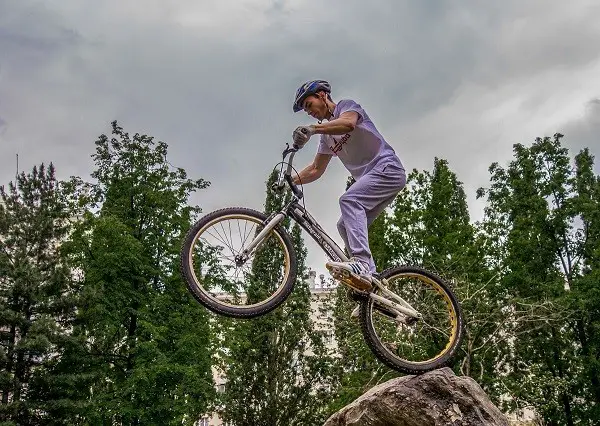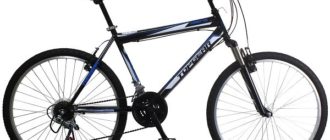Cycling triathlon is a separate kind of cycling sport, and an extremely difficult one at that. At the international level cyclist will be provided with bike breakages, bruises, abrasions, punctures of the wheels and many other unpleasant situations on the road.
Biketrial appeared in Spain in the 70-80s of the twentieth century. In general, the word “trial” translates from English as “attempt”, “misadventure”, “experience”. The name itself speaks for itself very eloquently. The cyclist expects a difficult track.
Major triathlon competitions are held in the U.S. and Spain. These two countries have fundamentally different riding styles and ways to overcome obstacles on two wheels.
What is a biketrial
Biketrial – what is it? Cycling triathal is a sport discipline, where the cyclist must complete the distance without getting off the bike. In other words, you need to overcome the distance on two wheels.
The task of the cyclist – to overcome obstacles in the route, without helping yourself with hands or feet. At the same track may contain high rises in the mountain, where you need to make two-meter jumps on the wheels, as well as pits, crates, logs, curbs and other inconveniences. Not every bike can handle such a load.
Types
Bicycle trialling has three main types:
- Street trial – overcoming obstacles within the city limits. Street trial has no high climbs or long descents. This direction is for amateurs, it is the most gentle both for the athlete and for the bike.
- Trial is a cross-country course. This is a more complex type of bicycle triathlon, because there are logs, rocks and sections on the road, where you need to make a difficult jump.
- Track competition – the route is on a specially prepared track. This is the most difficult type, suitable for professionals. Athletes learn in advance what obstacles await them, and prepare for each trick.
Tricky trial is performed within the city limits, so it can be safely attributed to street trials. Cyclists show their abilities in jumps, as well as when performing stunt elements on two, and sometimes even on one wheel.
Distinctive features of the types of trial bicycles
The track of the trial has many obstacles, where the city or mountain bike simply can not cope.
Therefore, a separate type of bicycle, which does not accelerate above 9 kilometers per hour, is produced for biketrials. Basically, the bicycle for the trial does not have a seat, because of which it is extremely uncomfortable to move around on it. These bikes are not made for riding in the city, so there is no point in torturing yourself or your bike while riding on a flat road to the store.
Trial bike is able to make a jump of 2-3 meters down, as well as jump on the obstacle, which is at a height of 1.5-2 meters. City, mountain or road bikes cannot boast of this.
Features
Trials bikes come in two varieties:
- Mod;
- Stock.
The main characteristics of a triathlon bicycle, regardless of the type:
- The weight of the bike is up to 12 kilograms. The lighter the bike, the easier it is to perform tricks and jumps.
- Rudder – made of carbon or aluminum, has different geometry. Beginners are advised to choose aluminum, as it is more comfortable.
- Brakes are mechanical discs. They must withstand sharp descents and sudden stops.
- The gear contains 2 stars, so the speed is not switched, it is only one.
- The wheels have a diameter of 20, 24 or 26 inches. This small wheel size provides durability and maneuverability.
Features
In order for an athlete to perform tricks, the bike must have the following features:
- The main feature is the lack of a seat, which helps the cyclist overcome obstacles in the form of holes, logs or curbs.
- Wide and sturdy pedals that have spikes. Due to the lack of a seat, the entire load of the cyclist’s weight is on the pedals. The foot should not slip under any circumstances. The athlete needs to be securely fixed so as not to fall when jumping or doing tricks.
- The frame should be rigid, because the bike will be exposed to various loads and impacts. It also contains auxiliary reinforcement that accounts for critical load points. Many frames are made of expensive titanium.
Variety of bicycles for trialling
As mentioned earlier, there are two varieties of bicycles for trialling, namely Mod and Stock.
- Mod or modified special bike is more like a Moutinbike. Its wheel diameter is 20 inches. For training, it is recommended to choose Mod. If you can handle it, then feel free to move to the Stock.
- Stock – larger in size and heavier than the Mod. Diameter of its wheels – 26 inches. But it can perform higher jumps. In addition, large wheels help improve the accuracy of tricks.
Popular models of bicycles for biketrials
The main models of bicycles for trialling:
- Norco RYDE 26;
- Stark Trial Mod;
- Stark Trial Team;
- Giant TRIALS Comp;
- Atom Trial Race.
Conclusion
Cycling trial is a great opportunity to test yourself and compete with other athletes in strength, endurance and ability to perform difficult elements on a bicycle.
If you love bicycles, and you enjoy performing stunts for the public on two wheels, then trialling combines this perfectly. But don’t forget about falls and bruises. Be careful and bravely enjoy riding your bike in unconventional conditions.










Cycling is one of my favorite activities, so I am interested in this topic. The article is interesting, I have not met yet a bike without a seat – the original model for the sport. I would even like to ride it.
Great article! It was really helpful in understanding the different types of triathlon bikes and their features. Thanks for taking the time to share this knowledge with us!
Great post! It’s really helpful to know the different types of triathlon bikes and their features. Thanks for sharing all this valuable information!